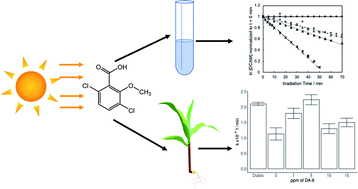Photolysis of the herbicide dicamba in aqueous solutions and on corn (Zea mays) epicuticular waxes†
Abstract
Dicamba, 3,6-dichloro-2-methoxybenzoic acid, has been used in agriculture as an herbicide for over fifty years, and has seen an increase in use in the past decade due to the development of glyphosate resistant weeds and soybeans genetically modified to resist dicamba. Despite the previous use of dicamba, many questions remain regarding its environmental fate, especially the new commercial formulations used on genetically modified crops. Here, the photolysis of dicamba, including the commercial formulation Diablo®, is examined in aqueous solutions of varying water quality and on the surface of corn epicuticular waxes. Dicamba is stable to hydrolysis but degrades under UV light. The photolytic half-life for dicamba photolysis in aqueous solutions at pH 7 irradiated with Rayonet UVB lamps (280–340 nm) was t1/2 = 43.3 min (0.72 hours), in aqueous solutions at pH 7 in a Q-Sun solar simulator (λ > 300 nm) was t1/2 = 13.4 hours, and on epicuticular waxes irradiated in the Q-Sun solar simulator was t1/2 = 105 hours. Experiments with adjuvants, compounds added into the commercial formulations of dicamba, led to increases in rate constants for both aqueous and wax experiments. In addition to kinetic rate constants, photoproducts were tentatively assigned for the aqueous solution experiments. This work deepens the knowledge of the environmental fate of dicamba including the role surfactants play in chemical reactions and in providing new applications of current methods to examine the photolysis of chemicals sorbed to surfaces.



 Please wait while we load your content...
Please wait while we load your content...